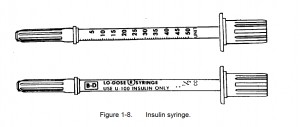a. When insulin is present within the blood, glucose is able to pass through the capillary membrane and into the body’s cells to be utilized for energy.
b. Insulin is measured in units. The most common strength of insulin is “U-100.” This means that 1 ml of the solution contains 100 units of insulin. U-100 syringes (fig. 1-8) are designed specifically for the administration of U-100 insulin. Use of other syringes, not calibrated in units, is a dangerous practice that allows for medication error.
c. Insulin is routinely refrigerated to prolong shelf life, but should be at room temperature when administered to prevent irritation of skin tissue.
d. Insulin is classified according to its action.
(1) Rapid-acting insulin includes regular and semilente.
(a) Onset of action occurs 1/2 to 1 hour after administration.

(b) Peak of action occurs 2 to 4 hours after administration. (about 6 hours for regular and about 14 hours for semilente).
c) Duration of action is relatively short (about 6 hours for regular and about 14 hours for semilente).
(2) Intermediate-acting types are NPH and lente.
(a) Onset of action occurs 2 hours after administration.
(b) Peak of action occurs 6 to 12 hours after administration. Lent peaks several hours later than NPH.
(c) Duration of action is of medium length (24 to 28 hours for NPH and 24 to 48 hours for lente).
(3) Long-acting types are protamine zinc and ultra lente.
(a) Onset of action occurs 6 to 7 hours after administration.
(b) Peak of action occurs 16 to 24 hours after administration.
(c) Duration of action is long, about 36 hours.
